| 1990 Pacific typhoon season | |
|---|---|
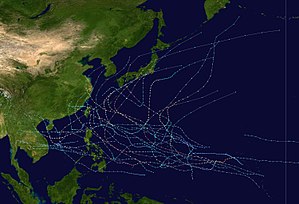 Season summary map Season summary map | |
| Seasonal boundaries | |
| First system formed | January 12, 1990 |
| Last system dissipated | December 23, 1990 |
| Strongest storm | |
| Name | Flo |
| • Maximum winds | 220 km/h (140 mph) (10-minute sustained) |
| • Lowest pressure | 890 hPa (mbar) |
| Seasonal statistics | |
| Total depressions | 41 |
| Total storms | 29 |
| Typhoons | 19 |
| Super typhoons | 4 (unofficial) |
| Total fatalities | 1,789 |
| Total damage | > $6.49 billion (1990 USD) |
| Related articles | |
| Pacific typhoon seasons 1988, 1989, 1990, 1991, 1992 | |
The 1990 Pacific typhoon season was another active season, with 29 storms being named during the year. It had no official bounds; it ran year-round in 1990, but most tropical cyclones formed in the northwestern Pacific Ocean between May and November. These dates conventionally delimit the period of each year when most tropical cyclones form in the northwestern Pacific Ocean.
The scope of this article is limited to the Pacific Ocean, north of the equator and west of the International Date Line. Storms that form east of the date line and north of the equator are called hurricanes; see 1990 Pacific hurricane season. Tropical Storms formed in the entire west Pacific basin were assigned a name by the Joint Typhoon Warning Center. Tropical depressions in this basin have the "W" suffix added to their number. Tropical depressions that enter or form in the Philippine area of responsibility are assigned a name by the Philippine Atmospheric, Geophysical and Astronomical Services Administration or PAGASA. This can often result in the same storm having two names.
Season summary

Systems
41 tropical cyclones formed this year in the Western Pacific, of which 31 became tropical storms. 19 storms reached typhoon intensity, of which 4 reached super typhoon strength.
Severe Tropical Storm Koryn
| Severe tropical storm (JMA) | |
| Category 1 typhoon (SSHWS) | |
 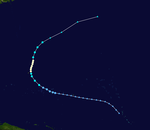 | |
| Duration | January 12 – January 17 |
|---|---|
| Peak intensity | 100 km/h (65 mph) (10-min); 980 hPa (mbar) |
On January 12, both the JMA and the JTWC identified a tropical depression in the northwest Pacific Ocean. The depression intensified over the period of a day to become a tropical storm on January 13, when it received the name Koryn from the JTWC. According to them, but not the JMA, Koryn reached typhoon strength on January 15, when it peaked in intensity. The storm then weakened quite rapidly until it became extratropical on January 17, at 0000 UTC.
Tropical Storm Lewis
| Tropical storm (JMA) | |
| Tropical storm (SSHWS) | |
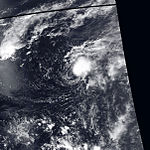  | |
| Duration | April 26 – May 3 |
|---|---|
| Peak intensity | 65 km/h (40 mph) (10-min); 998 hPa (mbar) |
Tropical Storm Lewis was a minimal tropical storm that only held said intensity for two days staying in the ocean
Typhoon Marian
| Typhoon (JMA) | |
| Category 2 typhoon (SSHWS) | |
  | |
| Duration | May 14 – May 19 |
|---|---|
| Peak intensity | 130 km/h (80 mph) (10-min); 965 hPa (mbar) |
Marian was a typhoon in the South China Sea.
CMA Tropical Depression 04
| Tropical depression (CMA) | |
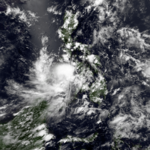  | |
| Duration | May 20 – May 23 |
|---|---|
| Peak intensity | 55 km/h (35 mph) (10-min); 1000 hPa (mbar) |
CMA Tropical Depression 05
| Tropical depression (CMA) | |
  | |
| Duration | May 24 – May 28 |
|---|---|
| Peak intensity | 55 km/h (35 mph) (10-min); 1000 hPa (mbar) |
Tropical Depression 04W
| Tropical depression (HKO) | |
| Tropical depression (SSHWS) | |
  | |
| Duration | June 14 – June 16 |
|---|---|
| Peak intensity | 55 km/h (35 mph) (10-min); 995 hPa (mbar) |
04W was short-lived.
Severe Tropical Storm Nathan (Akang)
| Severe tropical storm (JMA) | |
| Tropical storm (SSHWS) | |
  | |
| Duration | June 14 – June 19 |
|---|---|
| Peak intensity | 100 km/h (65 mph) (10-min); 980 hPa (mbar) |
A tropical disturbance trekked across the Philippines in mid June, upon entering the South China Sea a depression formed. The depression was upgraded to Tropical Storm Nathan on June 16. Tropical Storm Nathan reached peak intensity of 65 mph (100 km/h) shortly before striking Hainan Island. In the South China Sea the Chinese ship Tien Fu sank killing 4 people. In southern China torrential rains caused flooding in Guangdong Province killing 10 people, two people drowned in Macau due to high waves. Tropical Storm Nathan then continued northwestwards making a final landfall near the Vietnam/China border.
Typhoon Ofelia (Bising)
| Typhoon (JMA) | |
| Category 2 typhoon (SSHWS) | |
  | |
| Duration | June 16 – June 25 |
|---|---|
| Peak intensity | 120 km/h (75 mph) (10-min); 970 hPa (mbar) |
The monsoon trough spawned a tropical depression east of the Philippines on June 15. It tracked to the northwest then westward, slowly organizing into a tropical storm on June 18. Ofelia turned more to the northwest and became a typhoon on June 20. Paralleling the east coast of the Philippines, it reached a peak of 100 mph (155 km/h) winds before hitting Taiwan on June 23. Ofelia weakened over the country, and brushed eastern China before dissipating on June 25 near Korea. Ofelia caused heavy flooding throughout its track, resulting in at least 64 casualties.
Typhoon Percy (Klaring)
| Typhoon (JMA) | |
| Category 4 typhoon (SSHWS) | |
 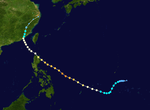 | |
| Duration | June 20 – June 30 |
|---|---|
| Peak intensity | 150 km/h (90 mph) (10-min); 950 hPa (mbar) |
Typhoon Percy, which developed on June 20, reached a peak of 135 mph winds while located a short distance east of the northern Philippines. Increasing vertical shear weakened Percy to a 95 mph typhoon before crossing extreme northern Luzon on the 27th, an area that felt the effects of Ofelia only days before. It remained a weak typhoon until hitting southeastern China on the 29th before dissipating on the 1st. Percy caused serious damage and flooding in the Carolina Islands and northern Philippines, amounting to 9 deaths.
Tropical Storm Robyn (Deling)
| Tropical storm (JMA) | |
| Tropical storm (SSHWS) | |
  | |
| Duration | July 4 – July 13 |
|---|---|
| Peak intensity | 85 km/h (50 mph) (10-min); 992 hPa (mbar) |
The outskirts of the storm brought 244 mm (9.6 in) of rainfall to Vladivostok in the Russian Far East.
CMA Tropical Depression 11
| Tropical depression (CMA) | |
  | |
| Duration | July 20 – July 23 |
|---|---|
| Peak intensity | 55 km/h (35 mph) (10-min); 1000 hPa (mbar) |
CMA 11 was a short lived system which hit Vietnam, bringing heavy rains, overall minimal damage.
Severe Tropical Storm Tasha (Emang)
| Severe tropical storm (JMA) | |
| Tropical storm (SSHWS) | |
  | |
| Duration | July 21 – July 31 |
|---|---|
| Peak intensity | 100 km/h (65 mph) (10-min); 980 hPa (mbar) |
65 mph Tropical Storm Tasha, which developed on July 21 and meandered through the South China Sea, hit southern China on the 30th, 75 miles east of Hong Kong. The storm caused torrential flooding in southern China, causing widespread damage and 108 fatalities.
Typhoon Steve
| Very strong typhoon (JMA) | |
| Category 4 typhoon (SSHWS) | |
  | |
| Duration | July 23 – August 2 |
|---|---|
| Peak intensity | 155 km/h (100 mph) (10-min); 940 hPa (mbar) |
Steve recurved out at sea.
Typhoon Vernon
| Typhoon (JMA) | |
| Category 2 typhoon (SSHWS) | |
  | |
| Duration | July 26 – August 5 |
|---|---|
| Peak intensity | 140 km/h (85 mph) (10-min); 955 hPa (mbar) |
Vernon followed Steve's track.
Severe Tropical Storm Winona
Main article: Tropical Storm Winona (1990)| Severe tropical storm (JMA) | |
| Category 1 typhoon (SSHWS) | |
 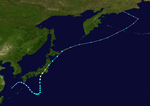 | |
| Duration | August 4 – August 11 |
|---|---|
| Peak intensity | 110 km/h (70 mph) (10-min); 975 hPa (mbar) |
The origins of Winona can be traced back to Severe Tropical Storm Tasha. On August 2, the remnant low of Tasha, as a patch of thunderstorms over northeastern China, was pushed to the east by a weather front from the west. By August 4, Tasha entered the Yellow Sea, before being pushed south by an anticyclone off northeastern Korea, into the East China Sea. Although the same system, Tasha was named Winona, as it started to strengthen into a tropical storm by August 7. It reached peak intensity with an eye-like feature on August 8, before landfalling over Japan the next day. Later, the remnants became extratropical.
Typhoon Yancy (Gading)
Main article: Typhoon Yancy (1990)| Typhoon (JMA) | |
| Category 2 typhoon (SSHWS) | |
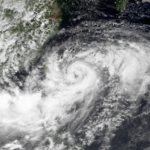  | |
| Duration | August 11 – August 23 |
|---|---|
| Peak intensity | 150 km/h (90 mph) (10-min); 950 hPa (mbar) |
Typhoon Yancy killed 12 people in the Philippines after a landslide destroyed a dormitory. In China, severe damage occurred and at least 216 people were killed. 20 people were killed in Taiwan.
Tropical Storm Aka
| Tropical storm (JMA) | |
| Tropical storm (SSHWS) | |
  | |
| Duration | August 13 (Entered basin) – August 15 |
|---|---|
| Peak intensity | 75 km/h (45 mph) (10-min); 994 hPa (mbar) |
On 15:00 UTC on August 13, a weakening Tropical Storm Aka crossed into the basin from the East Pacific, resulting in the Central Pacific Hurricane Center (CPHC) passing its responsibility to the Joint Typhoon Warning Center (JTWC). The next day, the JTWC downgraded Aka into a tropical depression since it had lost convection due to persistent wind shear caused by a nearby TUTT. On 12:00 UTC on August 15, the JTWC issued the last warning on the system, as it passed south of Wake Island.
Typhoon Zola
Main article: Typhoon Zola| Typhoon (JMA) | |
| Category 3 typhoon (SSHWS) | |
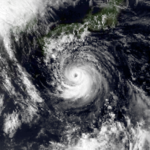 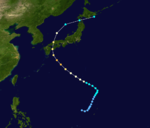 | |
| Duration | August 15 – August 25 |
|---|---|
| Peak intensity | 140 km/h (85 mph) (10-min); 960 hPa (mbar) |
On August 15, a large area of convection associated with the inflow of developing Typhoon Yancy was cut off, as Yancy was moving too fast to the west for the convection in the east to be absorbed into Yancy. By August 16, the convection developed a mid to low level circulation, and developed into tropical storm by August 18. Zola intensified into a typhoon by the next day, before reaching peak intensity on August 21. By the next day, Zola made landfall over Japan, before dissipating north of Japan. High winds and heavy rains produced by the storm killed three people and injured 22 others in Japan.
Typhoon Abe (Iliang)
| Typhoon (JMA) | |
| Category 2 typhoon (SSHWS) | |
  | |
| Duration | August 23 – September 2 |
|---|---|
| Peak intensity | 140 km/h (85 mph) (10-min); 955 hPa (mbar) |
Forming on August 23 from a tropical disturbance, the depression which would eventually develop into Typhoon Abe initially tracked in a steady west-northwestward direction. As a result of an intense monsoon surge, the system's trajectory briefly changed to an eastward then northward path before returning to its original track. Abe only intensified by a small amount between 0000 UTC August 24 and 0600 UTC August 27 due to the disruptive effects of the surge, and on August 30, Abe peaked in intensity as a Category 2-equivalent typhoon on the Saffir–Simpson hurricane wind scale. After peaking in intensity, Abe crossed the Ryukyu Islands and the East China Sea, making landfall in China where it affected the provinces of Zhejiang and Jiangsu before entering the Yellow Sea, crossing South Korea, and finally transitioning into an extratropical cyclone.
Typhoon Abe killed 108–195 people after it caused flooding and landslides in the Philippines and Taiwan, ravaged coastal areas of China, and brought high waves to Japan. Abe, which is responsible for killing 108 in China, affected half of Zhejiang's land area and a fourth of its population, leaving thousands homeless and causing ¥3.5 billion yuan (RMB, $741.5–743 million USD) to be lost in damages. Additional damage and one fatality occurred in Okinawa Prefecture in Japan, where at least ¥890 million yen (JPY, US$6 million) in damage was caused.
Typhoon Becky (Heling)
| Typhoon (JMA) | |
| Category 1 typhoon (SSHWS) | |
  | |
| Duration | August 23 – September 1 |
|---|---|
| Peak intensity | 130 km/h (80 mph) (10-min); 965 hPa (mbar) |
Tropical Storm Becky, having developed on August 20, hit northern Luzon on the 26th as a strong tropical storm. It strengthened over the South China Sea to an 80 mph typhoon, and hit northern Vietnam at that intensity on the 29th. Becky was responsible for killing 32 people and causing heavy flooding.
Tropical Storm Cecil
| Tropical depression (JMA) | |
| Tropical storm (SSHWS) | |
  | |
| Duration | September 2 – September 4 |
|---|---|
| Peak intensity | 85 km/h (50 mph) (1-min); 1002 hPa (mbar) |
Cecil hit China.
Typhoon Dot (Loleng)
| Typhoon (JMA) | |
| Category 1 typhoon (SSHWS) | |
  | |
| Duration | September 3 – September 11 |
|---|---|
| Peak intensity | 140 km/h (85 mph) (10-min); 960 hPa (mbar) |
Typhoon Dot formed from a monsoon trough to the southwest of Guam. Dot moved steadily towards the northwest and strengthened into a typhoon. Typhoon Dot reached peak intensity of 85 mph before weakening slight before landfall on eastern Taiwan on 7 September. After passing Taiwan Dot regained typhoon intensity in the Formosa Strait before making a final landfall in Fujian Province, China. On northern Luzon Island rains from Typhoon Dot caused floods killing 4 people, on Taiwan 3 people died.
Typhoon Ed (Miding)
| Typhoon (JMA) | |
| Category 2 typhoon (SSHWS) | |
  | |
| Duration | September 9 – September 20 |
|---|---|
| Peak intensity | 130 km/h (80 mph) (10-min); 965 hPa (mbar) |
Severe flooding produced by the storm killed at least 18 people in Vietnam. At least 4,500 homes were destroyed and another 140,000 were inundated.
Typhoon Flo (Norming)
Main article: Typhoon Flo (1990)| Violent typhoon (JMA) | |
| Category 5 super typhoon (SSHWS) | |
  | |
| Duration | September 12 – September 23 |
|---|---|
| Peak intensity | 220 km/h (140 mph) (10-min); 890 hPa (mbar) |
Typhoon Flo, which developed on September 12, rapidly intensified on the 16th and 17th to a 165 mph super typhoon near Okinawa. Vertical shear weakened it as it recurved to the northeast, and Flo hit Honshū, Japan, on the 19th as a 100 mph typhoon. It continued rapidly northeastward, became extratropical on the 20th, and dissipated on the 22nd. Widespread flooding and landslides killed 32 and caused millions in damage.
Typhoon Gene (Oyang)
Main article: Typhoon Gene| Typhoon (JMA) | |
| Category 1 typhoon (SSHWS) | |
  | |
| Duration | September 22 – September 29 |
|---|---|
| Peak intensity | 150 km/h (90 mph) (10-min); 950 hPa (mbar) |
A tropical disturbance consolidated into a tropical depression on the 23rd of September to the east of the Philippines. Tropical Storm Gene was named as the storm moved towards the northwest and strengthened into a typhoon the next day. Typhoon Gene reached peak intensity of 95 mph on the 27th shortly before recurving towards the northeast. Gene then skimmed the coasts of Kyūshū, Shikoku and Honshū Islands in Japan before moving out to sea and turning extratropical. Winds on 85 mph were recorded on Kyūshū and heavy rains fell across the region, resulting floods and landslides killed 4 people.
Typhoon Hattie (Pasing)
Main article: Typhoon Hattie| Typhoon (JMA) | |
| Category 2 typhoon (SSHWS) | |
  | |
| Duration | September 30 – October 8 |
|---|---|
| Peak intensity | 150 km/h (90 mph) (10-min); 950 hPa (mbar) |
Typhoon Hattie formed as Typhoon Gene was accelerating towards Japan. Hattie strengthened into a typhoon on 3 October while moving towards the northwest and reached a peak intensity of 105 mph the next day. Typhoon Hattie began to recurve while west of the island of Okinawa. Heavy rains from Typhoons Flo, Gene and Hattie broke the drought that plagued the island. As Hattie accelerated towards Japan it was downgraded to a tropical storm before brushing pass Kyūshū and Shikoku before making landfall on Honshū Island. Heavy rains caused a landslide on Shikoku Island killing three people when a landslide hit a bus.
Tropical Storm Ira
| Tropical storm (JMA) | |
| Tropical storm (SSHWS) | |
  | |
| Duration | October 1 – October 5 |
|---|---|
| Peak intensity | 65 km/h (40 mph) (10-min); 996 hPa (mbar) |
Severe flooding in Thailand triggered by heavy rains from Ira killed at least 24 people.
Tropical Storm Jeana
| Tropical depression (JMA) | |
| Tropical storm (SSHWS) | |
  | |
| Duration | October 12 – October 14 |
|---|---|
| Peak intensity | 65 km/h (40 mph) (1-min); 1004 hPa (mbar) |
Jeana hit southeast Asia.
Typhoon Kyle
| Typhoon (JMA) | |
| Category 2 typhoon (SSHWS) | |
 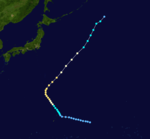 | |
| Duration | October 14 – October 22 |
|---|---|
| Peak intensity | 140 km/h (85 mph) (10-min); 955 hPa (mbar) |
A category 2 typhoon which did not impact land directly. It formed on October 14 and was classified as a Tropical Depression. It became a tropical storm and a typhoon later. Kyle reached a peak intensity of a Category 2 typhoon on September 20. Then, the storm turned eastward instead of affecting Japan. It stated to weaken and was classified as a tropical storm and eventually dissipated on the 22nd. Kyle did not cause any deaths or damages.
Tropical Storm Lola
| Tropical storm (JMA) | |
| Tropical storm (SSHWS) | |
  | |
| Duration | October 16 – October 20 |
|---|---|
| Peak intensity | 65 km/h (40 mph) (10-min); 998 hPa (mbar) |
Extreme rainfall, peaking near 31.5 in (800 mm) triggered extensive flooding that left some regions under 6 ft (1.8 m) of water. At least 16 people were killed by the storm.
Typhoon Mike (Ruping)
| Very strong typhoon (JMA) | |
| Category 5 super typhoon (SSHWS) | |
  | |
| Duration | November 6 – November 15 |
|---|---|
| Peak intensity | 185 km/h (115 mph) (10-min); 915 hPa (mbar) |
Super Typhoon Mike was the deadliest typhoon of the season. It struck the central Philippines in mid-November, where landslides, flooding, and extreme wind damage to caused over 748 casualties and over $1.94 billion in damage (1990 USD). The name Mike was retired after this season and replaced with Manny.
Severe Tropical Storm Nell
| Severe tropical storm (JMA) | |
| Tropical storm (SSHWS) | |
  | |
| Duration | November 9 – November 12 |
|---|---|
| Peak intensity | 95 km/h (60 mph) (10-min); 990 hPa (mbar) |
Nell also hit southeast Asia.
Tropical Depression Susang
| Tropical depression (JMA) | |
 | |
| Duration | November 15 – November 17 |
|---|---|
| Peak intensity | 55 km/h (35 mph) (10-min); 1004 hPa (mbar) |
Typhoon Owen (Uding)
| Very strong typhoon (JMA) | |
| Category 5 super typhoon (SSHWS) | |
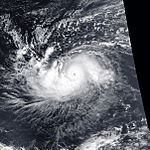  | |
| Duration | November 20 – December 4 |
|---|---|
| Peak intensity | 175 km/h (110 mph) (10-min); 925 hPa (mbar) |
As Super Typhoon Owen crossed the Marshall Islands and Caroline Islands in mid to late November, it caused extreme damage to the many islands. Some islands lost 95%-99% of the dwellings, as well as 80-90% crops being destroyed. Through all of the damage, Owen only killed 2 people.
Typhoon Page (Tering)
| Violent typhoon (JMA) | |
| Category 5 super typhoon (SSHWS) | |
  | |
| Duration | November 21 – November 28 |
|---|---|
| Peak intensity | 195 km/h (120 mph) (10-min); 910 hPa (mbar) |
Super Typhoon Page formed on November 21 as a tropical depression. From there, it tracked slowly westward, making a cyclonic loop. Page continued westward, and strengthened into a Category 5 typhoon. It then accelerated northeastward, making landfall in Japan on November 30 as a Category 1 typhoon. Page dissipated over northeast Japan on December 3.
Typhoon Russ
| Very strong typhoon (JMA) | |
| Category 4 typhoon (SSHWS) | |
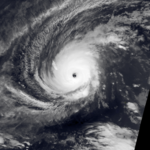  | |
| Duration | December 13 – December 23 |
|---|---|
| Peak intensity | 185 km/h (115 mph) (10-min); 915 hPa (mbar) |
The final storm of the season, Russ, formed on December 13. The typhoon brought heavy damage to Guam when it passed near the island on December 20. Damage estimates ranged as high as $120 million (1990 USD), but nobody perished in the storm.
Storm names
See also: Lists of tropical cyclone names and Tropical cyclone namingDuring the season 30 named tropical cyclones developed in the Western Pacific and were named by the Joint Typhoon Warning Center, when it was determined that they had become tropical storms. These names were contributed to a revised list which started on mid-1989.
| Koryn | Lewis | Marian | Nathan | Ofelia | Percy | Robyn | Steve | Tasha | Vernon | Winona | Yancy | Zola | Abe | Becky |
| Cecil | Dot | Ed | Flo | Gene | Hattie | Ira | Jeana | Kyle | Lola | Mike | Nell | Owen | Page | Russ |
Philippines
| Akang | Bising | Klaring | Deling | Emang |
| Gading | Heling | Iliang | Loleng | Miding |
| Norming | Oyang | Pasing | Ruping | Susang |
| Tering | Uding | Weling (unused) | Yaning (unused) | |
| Auxiliary list | ||||
|---|---|---|---|---|
| Aning (unused) | ||||
| Bidang (unused) | Katring (unused) | Delang (unused) | Esang (unused) | Garding (unused) |
The Philippine Atmospheric, Geophysical and Astronomical Services Administration uses its own naming scheme for tropical cyclones in their area of responsibility. PAGASA assigns names to tropical depressions that form within their area of responsibility and any tropical cyclone that might move into their area of responsibility. Should the list of names for a given year prove to be insufficient, names are taken from an auxiliary list, the first 10 of which are published each year before the season starts. Names not retired from this list will be used again in the 1994 season. This is the same list used for the 1986 season. PAGASA uses its own naming scheme that starts in the Filipino alphabet, with names of Filipino female names ending with "ng" (A, B, K, D, etc.). Names that were not assigned/going to use are marked in gray.
Retirement
Due to the severity of damage and loss of life caused by Mike, the name was retired and was replaced with Manny and was first used in the 1993 season. PAGASA also retired the name Ruping for similar reasons and was replaced with Ritang for the 1994 season.
Season effects
This table summarizes all the systems that developed within or moved into the North Pacific Ocean, to the west of the International Date Line during 1990. The tables also provide an overview of a systems intensity, duration, land areas affected and any deaths or damages associated with the system.
| Name | Dates | Peak intensity | Areas affected | Damage (USD) |
Deaths | Refs | ||
|---|---|---|---|---|---|---|---|---|
| Category | Wind speed | Pressure | ||||||
| Koryn | January 12 – 16 | Severe tropical storm | 100 km/h (65 mph) | 980 hPa (28.94 inHg) | Caroline Islands, Mariana Islands | None | None | |
| Lewis | April 28 – May 4 | Tropical storm | 65 km/h (40 mph) | 998 hPa (29.47 inHg) | Caroline Islands | None | None | |
| Marian | May 14 – 19 | Typhoon | 130 km/h (80 mph) | 965 hPa (28.50 inHg) | Philippines, Taiwan | None | None | |
| TD | May 20 – 23 | Tropical depression | Not specified | 1004 hPa (29.65 inHg) | Philippines | None | None | |
| TD | May 27 – 28 | Tropical depression | Not specified | 1006 hPa (29.71 inHg) | South China | None | None | |
| TD | May 31 – June 1 | Tropical depression | Not specified | 1004 hPa (29.65 inHg) | None | None | None | |
| 04W | June 13 – 15 | Tropical depression | 55 km/h (35 mph) | 1002 hPa (29.59 inHg) | None | None | None | |
| Nathan (Akang) | June 13 – 19 | Severe tropical storm | 100 km/h (65 mph) | 980 hPa (28.94 inHg) | Philippines, South China, Vietnam | None | 12 | |
| Ofelia (Bising) | June 16 – 25 | Typhoon | 120 km/h (75 mph) | 970 hPa (28.65 inHg) | Philippines, Taiwan, East China, Korean Peninsula | $207 million | 96 | |
| Percy (Klaring) | June 20 – 30 | Typhoon | 150 km/h (90 mph) | 950 hPa (28.05 inHg) | Caroline Islands, Philippines, China, Taiwan | None | 25 | |
| TD | July 1 – 2 | Tropical depression | Not specified | 1006 hPa (29.71 inHg) | Philippines | None | None | |
| Robyn (Deling) | July 4 – 12 | Tropical storm | 85 km/h (50 mph) | 992 hPa (29.29 inHg) | Philippines, Taiwan, Ryukyu Islands, South Korea | None | None | |
| TD | July 16 – 17 | Tropical depression | Not specified | 1008 hPa (29.77 inHg) | None | None | None | |
| TD | July 21 – 23 | Tropical depression | Not specified | 1002 hPa (29.59 inHg) | Vietnam | Minimal | None | |
| Tasha (Emang) | July 22 – August 1 | Severe tropical storm | 100 km/h (65 mph) | 980 hPa (28.94 inHg) | Philippines, South China, Vietnam | None | 108 | |
| Steve | July 23 – August 2 | Typhoon | 155 km/h (100 mph) | 940 hPa (27.76 inHg) | Mariana Islands | None | None | |
| Vernon | July 28 – August 9 | Typhoon | 140 km/h (85 mph) | 955 hPa (28.20 inHg) | None | None | None | |
| Winona | August 4 – 11 | Severe tropical storm | 110 km/h (70 mph) | 975 hPa (28.79 inHg) | Japan | $60.3 million | 1 | |
| Yancy (Gading) | August 11 – 22 | Typhoon | 150 km/h (90 mph) | 950 hPa (28.05 inHg) | Caroline Islands, Mariana Islands, Taiwan, China | $384 million | 284 | |
| Aka | August 13 – 15 | Tropical storm | 75 km/h (45 mph) | 994 hPa (29.35 inHg) | Marshall Islands | None | None | |
| Zola | August 16 – 23 | Typhoon | 140 km/h (85 mph) | 960 hPa (28.35 inHg) | Mariana Islands, Japan | $104 million | 6 | |
| Abe (Iliang) | August 24 – September 1 | Typhoon | 140 km/h (85 mph) | 955 hPa (28.20 inHg) | Caroline Islands, Mariana Islands, Ryukyu Islands, Taiwan, East China, Korean Peninsula | $748 million | 195 | |
| Becky (Heling) | August 24 – 30 | Typhoon | 130 km/h (80 mph) | 965 hPa (28.50 inHg) | Philippines, South China, Vietnam, Laos, Thailand, Burma | None | 32 | |
| Cecil | September 2 – 4 | Tropical storm | 85 km/h (50 mph) | 1002 hPa (29.59 inHg) | Taiwan, East China | None | None | |
| Dot (Loleng) | September 3 – 10 | Typhoon | 140 km/h (85 mph) | 960 hPa (28.35 inHg) | Mariana Islands, Philippines, China, Taiwan | None | 7 | |
| Ed (Miding) | September 9 – 20 | Typhoon | 130 km/h (80 mph) | 965 hPa (28.50 inHg) | Mariana Islands, Philippines, Vietnam, South China | None | 18 | |
| Flo (Norming) | September 12 – 20 | Typhoon | 220 km/h (140 mph) | 890 hPa (26.28 inHg) | Caroline Islands, Mariana Islands, Japan | $918 million | 40 | |
| TD | September 21 – 22 | Tropical depression | Not specified | 1008 hPa (29.77 inHg) | Philippines | None | None | |
| Gene (Oyang) | September 22 – 30 | Typhoon | 150 km/h (90 mph) | 950 hPa (28.05 inHg) | Japan | $158 million | 6 | |
| Hattie (Pasing) | September 30 – October 8 | Typhoon | 150 km/h (90 mph) | 950 hPa (28.05 inHg) | Japan | $9.9 million | 3 | |
| Ira | October 1 – 3 | Tropical storm | 65 km/h (40 mph) | 996 hPa (29.41 inHg) | Vietnam, Cambodia, Thailand, Myanmar | None | 24 | |
| Jeana | October 12 – 14 | Tropical storm | 85 km/h (50 mph) | 1002 hPa (29.59 inHg) | Vietnam, Cambodia | None | None | |
| Kyle | October 15 – 22 | Typhoon | 140 km/h (85 mph) | 955 hPa (28.20 inHg) | Mariana Islands | None | None | |
| Lola | October 16 – 19 | Tropical storm | 65 km/h (40 mph) | 998 hPa (29.47 inHg) | Vietnam, Cambodia, Thailand, Myanmar | None | 16 | |
| Mike (Ruping) | November 6 – 18 | Typhoon | 185 km/h (115 mph) | 915 hPa (27.02 inHg) | Caroline Islands, Philippines, Vietnam, South China | $448 million | 816 | |
| Nell | November 9 – 12 | Severe tropical storm | 95 km/h (60 mph) | 990 hPa (29.23 inHg) | Vietnam, Cambodia, Thailand | None | Unknown | |
| Susang | November 15 – 17 | Tropical depression | Not specified | 1004 hPa (29.65 inHg) | Philippines | None | None | |
| TD | November 16 – 18 | Tropical depression | Not specified | 1004 hPa (29.65 inHg) | Caroline Islands | None | None | |
| Owen (Uding) | November 20 – December 4 | Typhoon | 175 km/h (110 mph) | 925 hPa (27.32 inHg) | Marshall Islands, Caroline Islands | None | 2 | |
| Page (Tering) | November 21 – 30 | Typhoon | 195 km/h (120 mph) | 910 hPa (26.87 inHg) | Caroline Islands, Philippines, Japan | $33 million | 4 | |
| Russ | December 13 – 23 | Typhoon | 185 km/h (115 mph) | 915 hPa (27.02 inHg) | Marshall Islands, Mariana Islands, Caroline Islands | $120 million | None | |
| Season aggregates | ||||||||
| 41 systems | January 12 – December 23, 1990 | 220 km/h (140 mph) | 890 hPa (26.28 inHg) | $6.49 billion | 1,789 | |||
See also
- 1990 Pacific hurricane season
- 1990 Atlantic hurricane season
- 1990 North Indian Ocean cyclone season
- South-West Indian Ocean cyclone season: 1989–90, 1990–91
- Australian region cyclone season: 1989–90, 1990–91
- South Pacific cyclone season: 1989–90, 1990–91
References
- Gary Padgett. May 2003 Tropical Cyclone Summary. Archived 2010-11-30 at the Wayback Machine Retrieved 2006-08-26.
- Climate System Monitoring (CSM) Monthly Bulletin. World Climate Programme. 1993.
- ^ Joint Typhoon Warning Center. "SUMMARY OF WESTERN NORTH PACIFIC AND NORTH INDIAN OCEAN TROPICAL CYCLONE" (PDF). Archived from the original (PDF) on 2011-06-07. Retrieved 2010-01-01. Retrieved on 2007-12-26.
- Mariners Weather Log. U.S. Department of Commerce, National Oceanic and Atmospheric Administration, Environmental Data and Information Service. 1990.
- "Powerful Typhoon Goni targets Russia as forecasted". Russian News Agency. August 26, 2015. – via Lexis Nexis (subscription required)
- "Typhoon Yancy's Death Toll Reaches 216". www.apnewsarchive.com. Aug 29, 1990. Retrieved 2 February 2018.
- Michael Allaby (14 May 2014). Hurricanes. Infobase Publishing. p. 173. ISBN 978-1-4381-0867-4.
- ^ "The 1990 Central Pacific Tropical Cyclone Season". CENTRAL PACIFIC HURRICANE CENTER. Archived from the original on 2018-03-06. Retrieved 2024-01-25.
- ^ 1990 Annual Tropical Cyclone Report (PDF) (Report). Pearl Harbor, Hawaii: Joint Typhoon Warning Center. 1991. Archived from the original (PDF) on October 19, 2016. Retrieved August 19, 2014.
- ^ Tropical Cyclones in 1990 (PDF) (Report). Hong Kong: Royal Observatory. February 1992. Archived from the original (PDF) on October 23, 2019. Retrieved June 2, 2015.
- ^ Digital Typhoon: Weather Disaster Report (1990-936-12). Digital Typhoon (Report) (in Japanese). National Institute of Informatics. Retrieved June 6, 2015.
- ^ "Commodity Briefs". The Journal of Commerce: 9A. September 7, 1990 – via LexisNexis.
The typhoon hit the major wheat, sugar and cotton growing provinces of Zhejiang, Jiangsu and Anhui, as well as the city of Shanghai, on Aug. 31-Sept. 3, killing 108 people and causing 3.5 billion yuan (4.7 yuan=US$ 1) worth of damage, the China Daily said.
- DeAngelis, Richard A., ed. (February 1991). Mariners Weather Log: Winter 1991. Vol. 35. National Oceanographic Data Center. pp. 62 & 66.
There was no let–up as Abe came to life, on the 25th, 85 mi west southwest of Guam. Moving northward then west northwestward, Abe reached severe tropical storm strength on the 28th and became a typhoon the following day about 425 mi east southeast of Taipei. Abe moved across the Ryukyu Is and then made landfall about 150 mi south of Shanghai on the last day of the month." & "During Abe, one person was killed in Taiwan. On mainland China it was reported that 108 people lost their lives with another 40 reported missing. Zhejiang and Jiangsu provinces were hardest hit.
- "Storm Death Toll Rises to 88". Standard-Speaker. September 5, 1990. p. 3. Retrieved June 5, 2015 – via Newspapers.com. [REDACTED]
- Digital Typhoon: Weather Disaster Report (1990-918-06). Digital Typhoon (Report) (in Japanese). National Institute of Informatics. Retrieved June 6, 2015.
- Digital Typhoon: Weather Disaster Report (1990-927-02). Digital Typhoon (Report) (in Japanese). National Institute of Informatics. Retrieved June 6, 2015.
- "Thailand Floods Kill 24". Los Angeles Times. Oct 14, 1990. Archived from the original on October 23, 2012.
- "DIGEST: FLOODS DEVASTATE CENTRAL VIETNAM". Press-Telegram (Long Beach, CA). October 24, 1990.
- "Most Destructive Tropical Cyclones for Month of November (1948-2000)". PAGASA. Archived from the original on 2006-09-25. Retrieved 2007-02-04.
- ^ Japan Meteorological Agency. Japan Meteorological Agency's Typhoons' Best Track (1990-1999). Archived 2013-01-22 at the Wayback Machine Retrieved on 2015-01-05.
External links
- Satellite movie of 1990 Pacific typhoon season
- Japan Meteorological Agency
- Joint Typhoon Warning Center Archived 2010-03-01 at the Wayback Machine.
- China Meteorological Agency
- National Weather Service Guam
- Hong Kong Observatory
- Macau Meteorological Geophysical Services
- Korea Meteorological Agency
- Philippine Atmospheric, Geophysical and Astronomical Services Administration
- Taiwan Central Weather Bureau
| Tropical cyclones of the 1990 Pacific typhoon season | ||
|---|---|---|
 | STSKoryn TSLewis TYMarian TDTD TDTD TDTD TD04W STSNathan TYOfelia TYPercy TDTD TSRobyn TDTD TDTD STSTasha TYSteve TYVernon STSWinona TYYancy TSAka TYZola TYAbe TYBecky TDCecil TYDot TYEd TYFlo TYGene TYHattie TSIra TDJeana TYKyle TSLola TYMike STSNell TDSusang TYOwen TYPage TYRuss | |
| 1990–1999 Pacific typhoon seasons | |
|---|---|
| Tropical cyclones in 1990 | |
|---|---|
| Cyclones | |
| Hurricanes | |
| Typhoons | |
| Non-seasonal lists | |